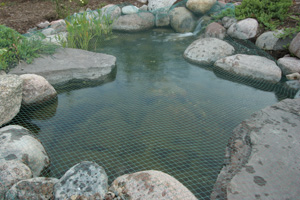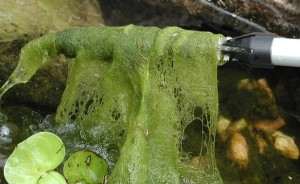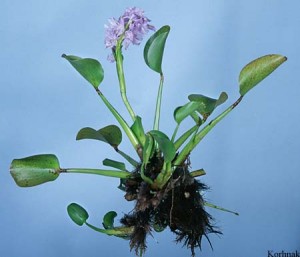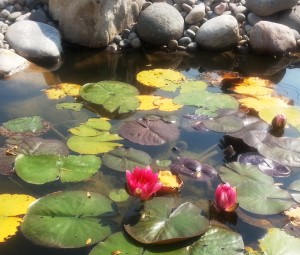Fall Care for the Backyard Pond
Fall Care for the Backyard Pond
It’s time to begin preparing your pond for the change in seasons. Fall is an important time of the year for keeping your backyard pond healthy and attractive not only for the fall but for next spring as well. By taking a few important steps now, you will not only save yourself a whole lot of clean-up in the spring, but your overall pond health will be so much better. Here are a few helpful tips to keep your pond and waterfall looking great.
 Use a pond net. The biggest headache for pond owners in the fall is the accumulation of leaves in the skimmer, filter, or on the bottom of the pond. If you have a skimmer your job will be fairly easy. Just empty the skimmer basket every few days to dispose of the leaves and keep the water flowing. But whereas you might have only had to empty the basket every week or two during the summer, you might have to do it several times a week when the leaves start to fall. A big time saver is to simply place a net over the entire surface of the pond. This keeps the leaves from falling to the bottom of the pond and creating a problem next spring. When the leaves have mostly fallen, simply remove the netting along with all the leaves. Special pond nets are available or you can just use bird netting.
Use a pond net. The biggest headache for pond owners in the fall is the accumulation of leaves in the skimmer, filter, or on the bottom of the pond. If you have a skimmer your job will be fairly easy. Just empty the skimmer basket every few days to dispose of the leaves and keep the water flowing. But whereas you might have only had to empty the basket every week or two during the summer, you might have to do it several times a week when the leaves start to fall. A big time saver is to simply place a net over the entire surface of the pond. This keeps the leaves from falling to the bottom of the pond and creating a problem next spring. When the leaves have mostly fallen, simply remove the netting along with all the leaves. Special pond nets are available or you can just use bird netting.- Reduce feeding of fish. Being a cold blooded animal, fish metabolism slows as the water temperature decreases. So ease up on the feeding. Make sure you don’t give them any more than they will eat in a few minutes. You might also consider switching to a spring/fall fish food that is formulated specifically for the colder times of year. Quit feeding entirely when the water temperature drops to 50 degrees.
 Remove excess algae. If you have a lot of string or blanket algae now would be a good time to physically remove it while the weather is still warm enough that you don’t mind playing in the water. When we redid our pond recently we had a huge bloom of string algae after we got the pond running again. When I tried to remove it, it literally came out in one piece. Well, actually three pieces. I would just grab some and start reeling it in and and created a pile on the side of the pond that looked like giant folds of green fabric. I let it sit on the side of the pond to drain a little so I could haul it off and my wife said, “What is that green fabric you have piled next to the pond?” It really did look amazingly like green felt fabric.
Remove excess algae. If you have a lot of string or blanket algae now would be a good time to physically remove it while the weather is still warm enough that you don’t mind playing in the water. When we redid our pond recently we had a huge bloom of string algae after we got the pond running again. When I tried to remove it, it literally came out in one piece. Well, actually three pieces. I would just grab some and start reeling it in and and created a pile on the side of the pond that looked like giant folds of green fabric. I let it sit on the side of the pond to drain a little so I could haul it off and my wife said, “What is that green fabric you have piled next to the pond?” It really did look amazingly like green felt fabric. Remove non-hardy plants. If you have tropical plants in your pond they will need to be moved inside for the winter, or discarded. This would include such plants as water lettuce, water hyacinths, umbrella palms, and tropical water lilies.
Remove non-hardy plants. If you have tropical plants in your pond they will need to be moved inside for the winter, or discarded. This would include such plants as water lettuce, water hyacinths, umbrella palms, and tropical water lilies.
Floating plants killed by frost should be immediately removed so that they do not add to the plant debris in your pond. Tropical plants should not be placed back into the garden in the spring until water temperature reaches 65-70 degrees (usually mid June).-
 Trim your perennial aquatic plants. They will begin going dormant as the weather cools. I took this picture of a water lilly in my pond today. As you can see many leaves are now turning yellow. If I don’t get them removed they will eventually fall to the bottom of the pond. So trim back the yellowing leaves. This simple trick will make your pond cleaning infinitely easier.
Trim your perennial aquatic plants. They will begin going dormant as the weather cools. I took this picture of a water lilly in my pond today. As you can see many leaves are now turning yellow. If I don’t get them removed they will eventually fall to the bottom of the pond. So trim back the yellowing leaves. This simple trick will make your pond cleaning infinitely easier.


